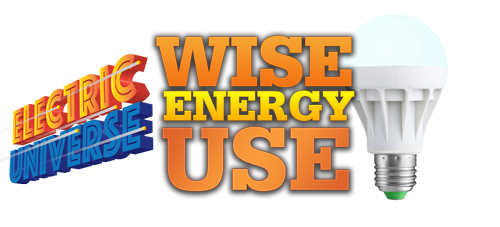
Location: Kitchen
Mission: Reduce energy waste with appliances; reduce water waste.
Follow these tips to save energy in the kitchen:
Dishwasher
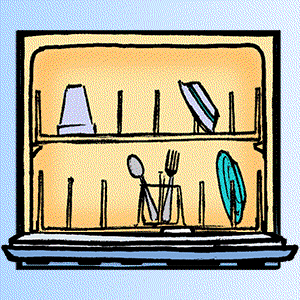 The dishwasher uses energy in two ways: 1-It requires electricity to run the unit. 2-It takes energy to heat the water that is used by the dishwasher.
The dishwasher uses energy in two ways: 1-It requires electricity to run the unit. 2-It takes energy to heat the water that is used by the dishwasher.
The best way to save energy with the dishwasher is to wash full loads. When you finish a meal, wipe the dish clean and store the dirty dish in the dishwasher, then run the dishwasher with a full load of dishes.
Use the “short cycle” setting if your dishwasher has one.
Putting large pots into the dishwasher takes up space that could be used for many other smaller items. Wash the big items by hand.
When possible, run the dishwasher at night. The extra heat generated while the unit is running will make the air conditioner run longer, which uses more electricity. At night, it is naturally cooler, which means the air conditioner will not need to work as hard to keep the house cool. In winter, the extra heat from the dishwasher will help warm the house.
The Oven and Stove
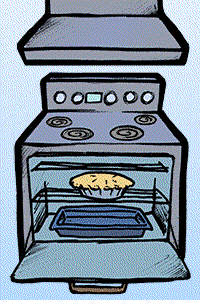 The oven needs electricity to run, but it also puts off heat, which makes your home’s air conditioner work harder. Follow these tips to conserve energy with your stove.
The oven needs electricity to run, but it also puts off heat, which makes your home’s air conditioner work harder. Follow these tips to conserve energy with your stove.
Don’t open the oven door more often than necessary to check the food. Opening the door allows heat to escape, which makes the oven and your air conditioner work harder.
Cook many items at one time in the oven. If you know you’ll be cooking something in the oven for lunch and something for dinner, cook them both at the same time and you won’t have to use the oven at night.
Reheat foods in the microwave and cook more in the microwave. Cooking in the microwave can save half the electricity and three-fourths of the cooking time and will not heat up the kitchen like the oven does.
Use glass cookware in the oven. Glass retains heat more than metal pans, thereby cooking your food more quickly.
More Oven and Stove Tips
 On the stovetop, don’t put small pots on big eyes. If the eye of the stove is bigger than the bottom of the pot, energy is being wasted.
On the stovetop, don’t put small pots on big eyes. If the eye of the stove is bigger than the bottom of the pot, energy is being wasted.
When boiling water on the stovetop, always cover the pot to make the water boil faster.
Use smaller appliances when possible. For example, make toast in the toaster or toaster oven instead of the full-size oven and save up to two-thirds of the energy!
Don’t line the oven racks with foil. Heat circulates within the oven when you cook. Lining the racks keeps the heat from circulating around the food.
During warm months, use the oven as little as possible. Cook outdoors on the grill and cook in the microwave as much as possible. This will keep the oven from heating up the house and making the air conditioner work harder.
The Refrigerator
Follow these tips to conserve energy with your refrigerator: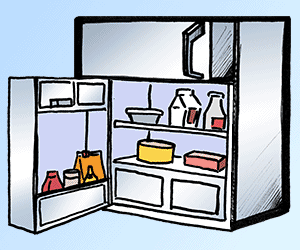 Check the seals on the refrigerator and freezer doors to make sure no cool air is escaping. The best way to test is by the “Dollar Bill Test” (see below).
Check the seals on the refrigerator and freezer doors to make sure no cool air is escaping. The best way to test is by the “Dollar Bill Test” (see below).
Use the “energy efficient” setting on your refrigerator if it has this setting. This will make the unit use less electricity.
Don’t store items such as paper bags behind or to the sides of the refrigerator. This restricts the airflow and makes the unit work harder.
Make a plan before you open the refrigerator or freezer. Knowing ahead of time what you want allows you to shut the door more quickly. The longer the door is open, the more cold air escapes and the more electricity is used.
Clean the refrigerator coils regularly twice each year.
Make sure the temperature settings are correct for your refrigerator and freezer. The freezer should be 0-5 degrees Fahrenheit. The refrigerator should be about 40 degrees. Try this test on your refrigerator to determine the temperature. Try the “Ice Cream Test” on your freezer (instructions below).
Keep the refrigerator away from heat sources. This includes the oven, heater vents and direct sunlight.
Unplug and get rid of old refrigerators that are stored in the garage or basement. Older model refrigerators can use up to three times as much electricity as newer models!
Now, let’s do some simple tests on your refrigerator!
The Dollar Bill Test
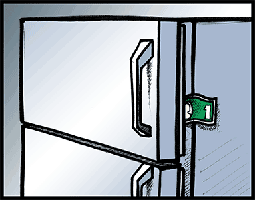 The Dollar Bill Test will help determine if the seals on the refrigerator door need replacing. Take a regular dollar bill and shut it in the refrigerator door with about half of it sticking out. Pull the bill out of the door while the door is closed. If the bill pulls out easily, air may be escaping, which means you should replace the seal on the refrigerator.
The Dollar Bill Test will help determine if the seals on the refrigerator door need replacing. Take a regular dollar bill and shut it in the refrigerator door with about half of it sticking out. Pull the bill out of the door while the door is closed. If the bill pulls out easily, air may be escaping, which means you should replace the seal on the refrigerator.
Take the Refrigerator’s Temperature
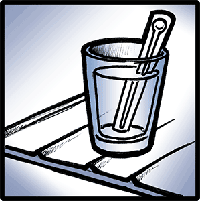 To determine the current temperature of your refrigerator, just fill a glass with water and put a thermometer in the glass and leave it in the refrigerator overnight. The next morning, take the thermometer out of the water and check the reading. The temperature should be 40 degrees or just a little less. Adjust your refrigerator’s settings to bring it to the correct temperature.
To determine the current temperature of your refrigerator, just fill a glass with water and put a thermometer in the glass and leave it in the refrigerator overnight. The next morning, take the thermometer out of the water and check the reading. The temperature should be 40 degrees or just a little less. Adjust your refrigerator’s settings to bring it to the correct temperature.
The Ice Cream Test
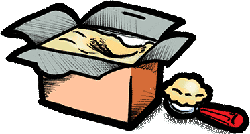 The ice cream test is the yummiest way to find out if your freezer setting is too low. To perform this test, just put some ice cream in the freezer. The next day scoop up a bowl of ice cream. If the ice cream is hard as a rock and hard to scoop out, the freezer setting is too low and should be adjusted to be a little less cold.
The ice cream test is the yummiest way to find out if your freezer setting is too low. To perform this test, just put some ice cream in the freezer. The next day scoop up a bowl of ice cream. If the ice cream is hard as a rock and hard to scoop out, the freezer setting is too low and should be adjusted to be a little less cold.
Other Places in the Kitchen
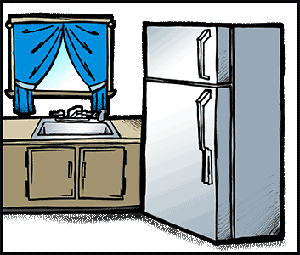 Be sure that the kitchen sink has an aerator. This will cut down on the water usage without giving up water pressure.
Be sure that the kitchen sink has an aerator. This will cut down on the water usage without giving up water pressure.
When your family shops for new appliances, it is important to consider the energy use rating. An item that appears to be a bargain could really cost more than a more expensive unit over time if it requires more electricity to run than a more efficient model.
The Energy Guide Label
 To find out about an appliance’s energy use rating, look for the Energy Guide Label when shopping for appliances. The label is usually big and very easy to find.
To find out about an appliance’s energy use rating, look for the Energy Guide Label when shopping for appliances. The label is usually big and very easy to find.
This label will tell you how the appliance you are considering compares with similar appliances.
The label contains a very useful bar scale. The scale shows the lowest and highest yearly energy use for similar models. It also gives the average yearly energy use for that particular model. As shown by Arrow 1 on the label to the right, this refrigerator uses about 776 kWh per year. Similar models use from 742 to 836 kWh per year.
Try to buy items that are on the lower end of the scale.
In addition to the energy use, the Energy Guide label also displays the yearly cost to operate the unit. On the label, we can see that the refrigerator will cost about $68 per year to operate (shown by arrow 2).
If you were shopping for a refrigerator and found this one and another one that had a lower price but used more energy per year, you could actually pay more over the life of the machine for the one that has the lower price. Read on to see how!
More About the Energy Guide Label
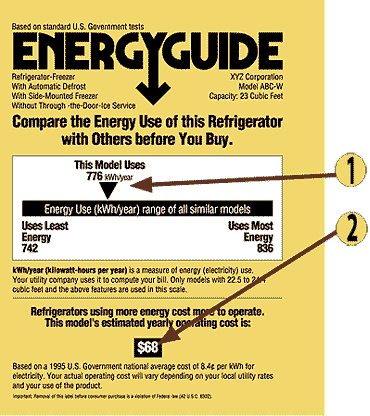 Let’s take a look at how spending less for a refrigerator could actually cost you more.
Let’s take a look at how spending less for a refrigerator could actually cost you more.
The unit on the label to the right sells for $600 and uses $68 per year in energy costs. After ten years, we would have paid $1280 to keep our food cold ($600 price plus $68 per year to operate).
Another unit sells for $500, but uses $90 of electricity per year. After ten years, we would have paid $1400 to keep our food cold ($500 price plus $90 per year to operate).
In this case, spending another $100 for the unit that uses less energy saves us a total $120 in the end ($1400-$1280). The refrigerator that costs more from the store actually costs us less over time!
When your family is shopping for appliances, be sure to consider the energy costs to operate the unit.
